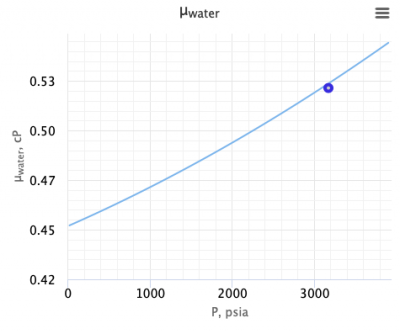Difference between revisions of "Water viscosity"
From wiki.pengtools.com
| Line 16: | Line 16: | ||
:<math> \mu_{w} = \mu_{w1} (0.9994 + 4.0295(10^{-5})\ P + 3.1062(10^{-9})\ P^2)</math><ref name= M1991/> | :<math> \mu_{w} = \mu_{w1} (0.9994 + 4.0295(10^{-5})\ P + 3.1062(10^{-9})\ P^2)</math><ref name= M1991/> | ||
| − | + | ==Example. Calculating water viscosity == | |
| − | |||
| − | |||
| − | |||
| − | |||
| − | |||
| − | ==Example. Calculating water | ||
| − | |||
===Input data=== | ===Input data=== | ||
:<math> C_{mg/l} = 74289.3</math> | :<math> C_{mg/l} = 74289.3</math> | ||
| + | :<math> SG_w = 1.0476</math> | ||
| − | Calculate water | + | Calculate water viscosity at 3176 psia and 165°F? |
===Solution=== | ===Solution=== | ||
| − | :<math> | + | :<math> C_W = 74289.3 / 1.0476 / 10000 = 7.1%</math> |
| + | :<math> A=68.83262779</math> | ||
| + | :<math> B=0.984227021</math> | ||
| + | :<math> \mu_{w1} = 0.45</math> | ||
| + | :<math> \mu_w = \mu_{w1} 1.1587 = 0.52 cP</math> | ||
== Nomenclature == | == Nomenclature == | ||
:<math> C_{mg/l} </math> = pressure correction, res bbl/STB | :<math> C_{mg/l} </math> = pressure correction, res bbl/STB | ||
| − | :<math> | + | :<math> C_W </math> = water salinity or weight percent solids, % |
:<math> P </math> = pressure, psia | :<math> P </math> = pressure, psia | ||
:<math> T </math> = Temperature, °F | :<math> T </math> = Temperature, °F | ||
| + | :<math> \mu_w </math> = water viscosity, cP | ||
==See also== | ==See also== | ||
Revision as of 06:45, 2 October 2020
Contents
Water viscosity
The formation water (brine) isothermal viscosity correlation is published by McCain in 1991[1].

Water viscosity [2]
Math and Physics
where
Example. Calculating water viscosity
Input data
Calculate water viscosity at 3176 psia and 165°F?
Solution
Nomenclature
 = pressure correction, res bbl/STB
= pressure correction, res bbl/STB = water salinity or weight percent solids, %
= water salinity or weight percent solids, % = pressure, psia
= pressure, psia = Temperature, °F
= Temperature, °F = water viscosity, cP
= water viscosity, cP
See also
References
- ↑ 1.0 1.1 1.2 1.3 1.4 McCain, W.D. Jr. (1991). "Reservoir-Fluid Property Correlations-State of the Art"
 . Society of Petroleum Engineers (SPE-18571-PA).
. Society of Petroleum Engineers (SPE-18571-PA).
- ↑ McCain, W.D. Jr. (1990). Properties of Petroleum Fluids (2 ed.). Oklahoma: PennWell Corp. ISBN 978-0878143351.











